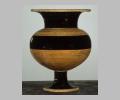Chapter25 |
Images |
Croesus and ancient Lydia
Clicking on the thumbnail will open a new browser window.
| Sardis, the capital of Lydia, is situated on the Hermus Plain between Mount Tmolus and the Pactolus River. Under the dynasty founded by King Gyges through the reign of King Croesus (560-547 BCE), Lydia was known as one of the most powerful and richest kingdoms of Asia, in large part because of alluvial deposits of gold and silver. This image shows the acropolis of Sardis (center) and the rich agricultural land of the Hermus Plain (foreground) and Mount Tmolus (background). One can see its location on this map of the Persian empire. | |
Six miles northwest of the Sardis acropolis are the great burial mounds of Bin Tepe where the great kings of Lydia were buried. It was not uncommon in ancient Anatolia to bury a king in an artificial hill. Herodotus (Book 1.93) compares the great burial mound of Alyattes, Croesus' father, to the Egyptian pyramids. Yet its size dwarfs the pyramids since, according to Herodotus, its diameter was 355 meters and its height was 69 meters high. |
|
| This Lydian coin called a trite was probably minted during Croesus' reign. It is made of electrum, an alloy. Its obverse shows a lion with a wart on its nose. Its reverse shows two squares hammered into the coin, one of the squares slightly larger.
"The Lydians are generally supposed to have invented coinage as we know it," said Andrew Ramage, author of King Croesus' Gold: Excavations at Sardis and the History of Gold Refining. "And they are specifically credited with introducing separate gold and silver coins, rather than the mixture known as electrum that had been in use previously." |
|
This coin, a gold stater, was minted in Lydia perhaps during Achaemenid (Persian) rule. It depicts a lion and a bull facing each other. |
|
| This elegant vase was made near the time that Croesus was king of Lydia. It has a wide black band the circles the belly of the vase and many more black bands running horizontally around the vase. | |
| These beautiful drinking cups come from Lydian homes (600-550 BCE) and are decorated in an orientalizing style. | |
| Lydians were expert at using mud and clay to build their houses and in designing ceramics for other uses, too. This modern reconstruction of architectural tiles show how Lydian houses would have been decorated and how rainwater would have run off the rood without damaging the mudbrick below. | |
| This helmet, made of iron and tipped with bronze, comes from the Harvard-Cornell excavations of Sardis. It dates from the time that Lydia was conquered by Cyrus, King of Persia. |
Image credits: Electrum trite. Dewing 2422. Gold stater. Dewing 2431. Photographs by Maria Daniels, courtesy of the Dewing Greek Numismatic Foundation, September 1990
Lydian vase. Philadelphia L-64-173. Photograph by Maria Daniels, courtesy of The University Museum, University of Pennsylvania, October 1991
Iron helmut.
© Archaeological Exploration of Sardis/Harvard University 1996







